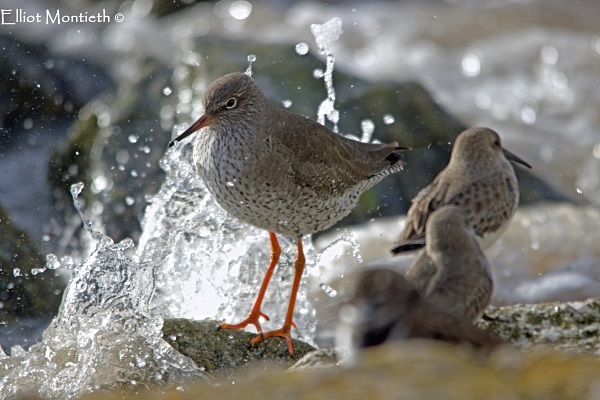Site menu:
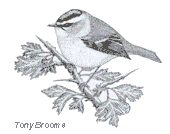
February 2016 Newsletter
The Mysterious Pallas's Warbler.
Colour Ring Report.
January Bird News.
Forthcoming Events.
Latest Newsletter.
The Mysterious Pallas's Warbler.

When Stephen Hinde rang me on Jan 2nd
to say he had
a Pallas's Warbler at Target Road, Heswall, two thoughts crossed my
mind - the first was that it was another great find by Steve, the
second was that I realised how little I knew about this species other
than a vague recollection that they come from the far-east - but what
exactly
was a tiny warbler doing in Heswall in early January when it
really should be an awful lot closer to Hong Kong? A brief
search
on Google revealed that a lot of eminent ornithologists have been
trying to answer that very question.
But before I briefly discuss the various papers written on this subject I'll summarise Pallas's Warbler's status in this country and around the Dee estuary.
UK Status
It's full name is Pallas's Leaf Warbler (Phylloscopus proregulus) and is part of a 'Superspecies' which has been split into several very closely related species and sub-species - but the nominate sub-species P.p. proregulus is thought to be the one that visits the UK.

The records in the UK show a sharp increase through the late 20th century and the first five years of this century with a peak of 313 in 2003. Since 2005 there has been a distinct fall in numbers although 2015 was a relatively good year with around 69 records (compared to just 20 in 2012). Prior to 1971 there was only one year in double figures (19 in 1968), it was regarded as a very rare vagrant then and in many years none were seen. So that's the first mystery - why this relatively huge increase? Will numbers continue to fall back down to 1970s levels?
Pallas's Warbler's distribution in the UK, both geographic and by date, is intriguing. The vast majority are found within a stone's throw of the coast between the Shetland Islands, down the east coast of the UK and along the south coast as far as the Scilly Isles, and nearly all arrive from the second week in October to the first week in November. A few of these birds linger into early December but we had to wait until 1987 before the first one was recorded into late December. Up until 2000 over-wintering birds were virtually unheard of but since then they have become more frequent and almost annual. Spring records are of particular interest as they tell us that some birds do survive the winter in Europe (or maybe Africa), but spring sightings are very rare; up to 2007 there had been just three (1975, 2000 and 2004) then we had two in 2007 and four in 2008 but none since.
Dee Estuary Status
This species is very much a vagrant on the west coast of the UK and the handful of records around the Dee Estuary are not untypical, as follows:
1. Bidston - Nov 25th 1980.
2. Lingham Lane, Moreton - Oct 28th 1988.3. Hilbre - Oct 31st 1997.
4. Hoylake - Nov 9th to 12th 1997.
5. Bidston - Nov 7th 2010 (trapped in the same garden as the 1980 bird!).
6. Heswall - Jan 2nd to 13th 2015.
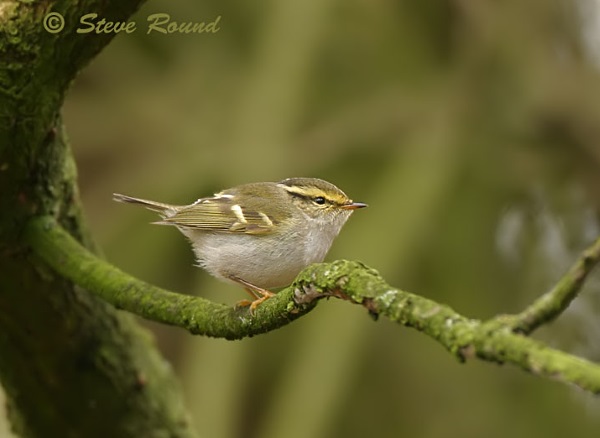
www.stevenround-birdphotography.com/
I've been unable to find any records
for Clwyd but there is one other
for Cheshire with one at Crossley, near Congleton, from Jan 29th to Feb
22nd 2005; a doubly rare bird being both inland and found in late
winter.
Mysterious Migration

The map above shows the breeding area for Pallas's Warbler (yellow) and the normal wintering area (blue), the large arrow shows the normal south-east migration for those breeding in the western part of the area, and the small arrow the probable migration route for those that fly the 'wrong way' to the UK.
The mysteries:
a. The biggest one is that the westward migration happens at all - what
makes a tiny ball of feathers, weighing no more than a
Goldcrest, decide to fly about 3,000 miles west when the vast majority
of the species fly up to 3,000 miles south-east?
b. The large majority of European records come from Finland, southern
Sweden and the UK, why such a narrow flight path?
c.
Why do birds arrive in the UK in a narrow time window with most turning
up
within a few days of each other? Pretty remarkable given the long
overland journey and that their breeding ground stretches around 2,000
miles west to east.
d. Where do the birds go after arriving in the
UK in October and November? The vast majority just disappear, our
Heswall bird being an exception to this.
e. If the birds continue
flying south-west across the UK and out into the Atlantic why are there
so few records in Ireland and the Hebrides? And why are there no
records from the Azores and Canary Islands? If the birds fly due south
why are there so few records from Portugal, Spain or West Africa?
f.
Why was there a dramatic rise in numbers through the 1980s and 1990s
followed by a sharp drop in numbers from 2005 (there are large
fluctuations in annual totals, e.g. 18 in 2001 was followed by 313 in
2003 but had dropped to just 10 by 2006)?
g. All the 'wrong way' migrants appear to be juveniles, why is that?
These
are some of the questions which many people have tried to answer,
including in the articles referenced below. Having read a lot of them I
have to say that no theory satisfactorily answers all these questions.
The theories mainly revolve around two main themes, (i) the
effect of weather (e.g. drift migration) and (ii) a fault with the
bird's navigation usually assumed to be due to genetic mutation but
could be due to some environmental affect. Weather no
doubt has an impact on the survival of migrating birds and, to
some
extent, their time of arrival in the UK but most commentators agree
that it is not a satisfactory answer to the questions posed above. As
for faulty navigation there is one theory which has been discussed more
than any other - Reverse Migration.
Reverse Migration
Up until 2003, when Gilroy & Lees published their article, Reverse Migration was thought to be a good explanation for Asian vagrants, such as Pallas's Warbler, turning up in the UK (Robol; Thorup; Vinicombe & Cottridge). Since then the theory has rather gone out of fashion, unfairly in my opinion as it does answer at least some of the questions above, namely (a), (b) and (c) - probably more than any other theory.
Reverse Migration happens when individual birds experience reversed polarity with their internal navigational mechanisms mistaking north for south so that they fly at a 180º angle to the normal migration direction - as shown in the map above. The birds appear to fly a great circle route which neatly explains why they are first recorded in Finland, followed by Sweden before arriving in the UK by which time they are flying SW rather than NW. Exactly why this reversed polarity happens is unclear but is probably a genetic defect which seems to affect a small number of juveniles.
Having travelled about 3,000 miles overland to the UK it has always astonished me that the majority of Pallas's Warblers arrive within a few days of each other in one wave. The implication of this is that they all departed together from quite a small area, if they had come from right across their breeding range, which is 2,000 miles west to east, then their arrival would be much more drawn out. But this is exactly what you would expect with Reverse Migration, the birds in the western most part of their breeding area would normally depart to the south-east, the reverse of which is north-west. But for birds further east their normal migration direction is due south, the reverse of which is north where they must end up in the far north of Siberia and the Arctic Ocean and not Europe.
As you see from question (g) it is assumed that all the Pallas's Warblers that reach the UK are juveniles. We don't actually know if that really is the case as it is impossible to age them in the field by the time they reach here, however it is possible to age them in the hand and all ringed birds which have been aged have all been juveniles including 16 in the UK between 2010 and 2014. So it would seem that the navigation defect which causes the birds to migrate the wrong way, whether genetic or otherwise, only effects juveniles.
Since 2003 some authors have given the impression that Gilroy & Lees disproved Reverse Migration but that is not the case and I quote from their article "Strong supporting evidence for Reverse Migration theory came from specific case studies". Their main arguments are twofold - that Reverse Migration is being applied too widely to too many species and that the pattern of records could be explained by observer bias; the latter caused simply by the fact that there are more birders and ringers in north-west Europe so more records come from there whilst birds flying elsewhere (e.g. Middle East, Mediterranean and Africa) are largely missed. Interestingly Juana disputed this, at least for Iberia, arguing that there are good numbers of ringers in Portugal and Spain, comparable to those in north-west Europe, yet very few Pallas's Warblers are caught in Iberia, hence the lack of birds must be real and not an artefact of observer bias.
Gilroy & Lees, Juana and others have suggested various alternatives to Reverse Migration with theories such as 'exploratory migration' and 'pseudo-vagrancy', but these are very speculative and for the latter requires an unknown wintering area of adult Pallas's Warblers in western Europe and/or Africa, for which there is no evidence whatsoever. Reverse Migration may not be the answer to all the above questions and Gilroy & Lees were quite right to point out it's flaws, but, at least for Pallas's Warbler, it is still the one theory which does more to explain this mysterious migration than any other.
Richard Smith

https://greensnappa.wordpress.com/
References and Further Reading regarding vagrancy and related theories:
1. J. Robol, Reversed migration as the cause of westward vagrancy by four Phylloscopus warblers, British Birds 62, March 1969.
2. K. Vinicombe & D. Cottridge, Rare Birds of Britain and Ireland, Collins, 1997.
3. K. Thorup, Vagrancy of Yellow-browed Warbler and Pallas's Warbler in north-west Europe: Misorientation on great circles?, Ringing & Migration 19: 7-12, 1998.
4. J. Gilroy and A. Lees, Vagrancy theories: are autumn vagrants really reverse migrants?, British Birds 96, September 2003.
5. K. Thorup, Reverse migration as a cause of vagrancy, Bird Study, 51: 228-238, 2004.
6. E. Juana, Where do Pallas's and Yellow-browed warbler go after visiting Northwest Europe in Autumn? An Iberian Perspective, Ardeola, 55 (2), 2008.
Other References:
7. D. Howey & M. Bell, Pallas's
Warblers and other migrants in Britain and Ireland in October 1982,
British Birds
78, August 1985.
8. Azores Bird Club Rare Bird Database (http://www.birdingazores.com/).
9. Reports on rare birds in Great Britain, various editions of British Birds.
10. Reports on scarce migrant birds in Britain, various editions of British Birds.
11. J. Martens et. al, Radiation and species limits in the Asian Pallas's Warbler complex, Journal of Ornithology, January 2004.
12. Cheshire and Wirral Bird Report 2005, CAWOS.
13. J.N. Dymond et. al, Rare Birds in Britain and Ireland, T & A D Poyser Ltd, 1989.
14. BTO - http://www.bto.org/volunteer-surveys/ringing.
Colour Ring Report
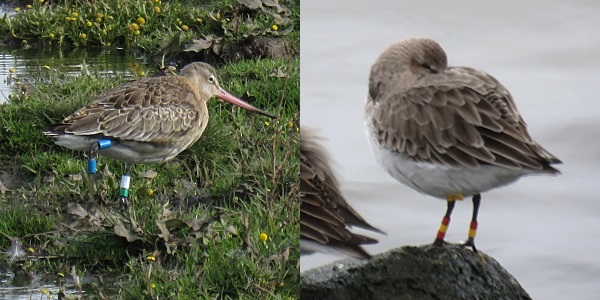
It's not been a good winter for
colour-ringed birds with not many wader or gull flocks close enough to
scan, and for those few we have seen we've often had to wait ages for
feedback. So here are details of the two photographed above - a
juvenile Black-tailed Godwit we saw in the autumn and a German ringed
Dunlin, plus a couple more interesting Black-tailed
Godwits.
Black-tailed Godwits
WG-B//B
-
one of several ringed juveniles we saw in 2015 returning from Iceland,
most years we don't see any so hopefully that means they had a good
breeding season.
Ringed as a migrating juvenile at Meikle Loch in
NE Scotland on August 23rd 2015, and seen a few days later on the Ythan
estuary.
Arrived at the flooded field by Gilroy Nature Park, West
Kirby, in late September and recorded there ten times up until October
26th.
LR-Y//W -
this bird must be at least 20 years old.
Ringed on the Wash as an adult female on September 7th 1998.
Recorded on Thurstaston shore late November 2015 and at Burton Mere
Wetlands on January 1st 2016.
First
record after ringing was at Inner Marsh Farm in April 1999 and it was
there again in April 2000. Most records came from the east coast of the
UK (Humber estuary and Norfolk) up until December 2000 when it was a
Marshside, Lancs.
It was spotted in Iceland in May 2001
which is the only record outside this country. There were just two
records from then until December 2007 when it was on Thurstaston Shore.
Apart from occasional visits to Leighton Moss and Marshside nearly all
winter and early spring records then came from Thurstaston but it
preferred the Wash during the return migration in late summer and early
autumn, including September 2015.
Ringed in the Montrose Basin, Scotland,
as an adult on September 30th 2007.
Present on the Dee estuary, mainly on Thurstaston shore, between August
20th and September 24th 2013. The only other time it's been recorded in
the UK was August and September 2015 when it was on the Blackwater
Estuary, Essex.
This bird spends every winter in Portugal on the Algarve returning via
the Netherlands in early spring. An interesting north-east
movement but one undertaken by quite a few islandica birds
wintering in south-west Iberia. It seems probable that they migrate
with limosa
birds (which breed in the Netherlands) which winter in large numbers
both in southern Spain and Portugal as well as West Africa.
Dunlin
Yflag//RYR-RY.
Ringed at Jade Bay, German Wadden Sea, on May 15th 2010.
Recorded on the rocks by West Kirby Marine Lake on December 9th and
10th 2015.
Richard
Smith and Matt Thomas.
Colour-ringed birds were also recorded by Steve Hinde, Mike Giverin,
Paul Ralston and Colin Schofield.
January Bird News
A Pallas's Warbler which turned up in
the thick hedges along Target Road, Heswall, was undoubtedly the bird
of
the month (see above article), it was first seen on the 2nd and
remained for just under two weeks. The day I went to see it I was lucky
and had a good view but I was also fascinated by the number of other
small birds flitting around the hedges - these were various tit
species, Goldcrests, overwintering Chiffchaffs and even a Firecrest.
Normally I walk past here in a hurry to get to the shore and tend to
miss this spectacle.

Although it was yet another wet and
windy month we did get a few still days and the 11th produced a flat
calm sea; I managed a good count of 394 Great Crested Grebes off north
Wirral but further out was a cloud of Common Scoters and I estimated
one large flock of 2,000 flying east to west plus at least another
1,000 on the sea. There were two counts off Hoylake of 18 Goldeneye
through the month and a Little Auk and Great Northern Diver flew past
there on the 12th with a Velvet Scoter on the 23rd. Another Little Auk
was
spotted on the sea just of the Connah's Quay Reserve on the 10th, blown
in by overnight gales.
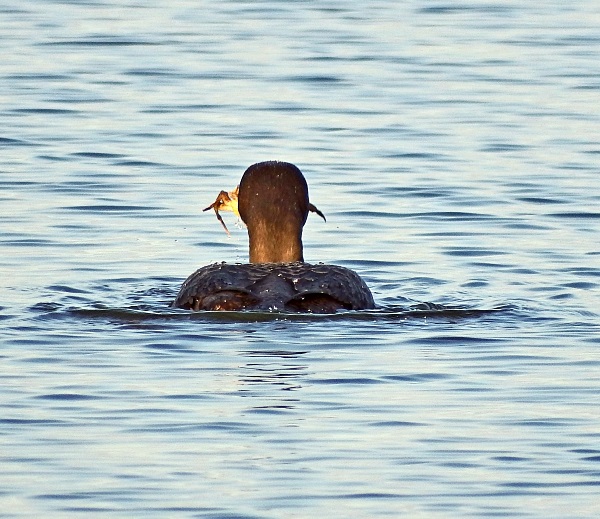
The juvenile Great
Northern Diver remained on West Kirby Marine Lake all month and it
seemed to be feeding exclusively on crabs. A very unusual sight was of
10 Brent
Geese swimming on the Marine Lake on the 10th and this one below was
casually feeding on seaweed just a few feet from parked cars in the car
park at the north end. The highest count of Brent at Hilbre was 232 on
the 15th,
a fairly typical max count for recent years.
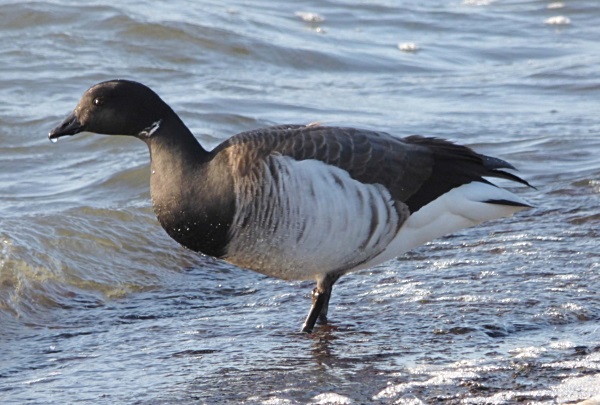
It was a fairly quiet month on Hilbre
with the highlight probably being the sighting of a Great Skua, very
much a vagrant in January. It was seen eating an Oystercatcher which
had originally been caught by, and dropped by, a Peregrine. The 9th was
a good day with a Long-tailed Duck and three Scaup, 1,800 Cormorants
flew out of the estuary past the island at dawn (see Species Spotlight
- Cormorant).
Just how many Great White Egrets we had
on the marshes is difficult to say but at least three and may well be
five
or more. There were also two Marsh Harriers and two or more Hen
Harriers with three Short-eared Owls.
 Marsh Harrier and Snipe at Parkgate, January 25th © Roy
Lowry.
Marsh Harrier and Snipe at Parkgate, January 25th © Roy
Lowry.
Purple Sandpipers at New Brighton peaked at 12 and four Greenshank at
Parkgate on the 24th was a good number for this month. Single
Greenshank continue to over winter at Heswall and north Wirral.
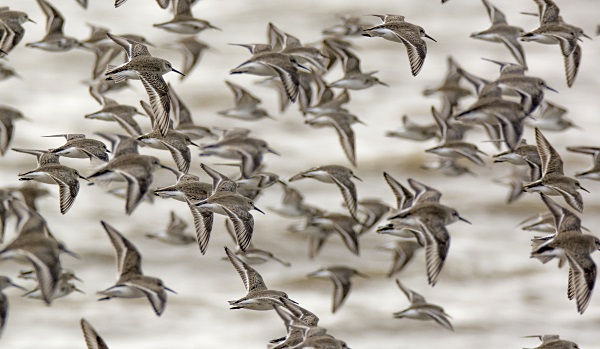
Richard Smith.
What to expect in February
Going by the last two years Scoter numbers will build up to several thousand giving some fantastic views, if somewhat distant. We would expect to see several Velvet Scoters and one or two Surf Scoters if they come close enough to identify (see "How Many Scoters?" article). A calm sea is best for viewing these rarer ducks and in those conditions we should also get several hundred Great Crested Grebes plus a selection of divers and may be Scaup or even Long-tailed Ducks.
Late winter often sees a huge build up of Herring Gulls on the sand banks with maybe as many as 20,000 or more - off north Wirral they usually roost at Hoylake at high tide and feed of Leasowe at low tide, large numbers can also be viewed from Hilbre and between Point of Ayr and Gronant. We could have large numbers of waders at their main roost site at Hoylake but so far this winter it has been disappointing there. Purple Sandpipers usually reach a maximum this month with New Brighton Marine Lake during a big tide the best place to see them, some years we can get as many as 20 there.
We could also see the first signs of spring, as well as the woods full of singing birds on mild days we could have the first Avocet returning to Burton Mere Wetlands and it's not unknown for a Sand Martin to turn up by the end of the month.
Top of Page
Forthcoming Events
February Highest Spring Tides (Liverpool)
Also
see Tides
page.
9th February, 11.33hrs (GMT), 9.7m.
10th February, 12.15hrs (GMT), 10.0m.
11th February, 12.57hrs (GMT), 10.0m.
12th February, 13.41hrs (GMT), 9.9m.
Forthcoming Events
Organised by the Wirral
Ranger Service , Flintshire
Countryside Service and the
RSPB (Dee Estuary):
All these events and walks have bird interest, even those not
advertised specifically for birdwatching. No need to book for these
events unless specified - please check below.
Also see 2015 Events Diary.
1 pm - dusk
Price: Free
Most people have never seen a hen harrier, but once seen it is rarely forgotten. In support of the RSPB's Skydancer project, we are pleased to bring you a series of events to showcase these enigmatic birds of prey which use the marshes of the Dee Estuary as their home for the winter months.
The name "Skydancer" comes from the aerobatic displays that the male birds perform in their courtship ritual on the moors in the spring. Sadly, this has become an increasingly rare sight and they are close to becoming extinct as a breeding bird in England.
This could be the last chance to see Skydancers on the Dee, so come along to Parkgate to find out more about the hen harrier story and what you can do to help save them before it's too late. Look for the RSPB marquee along the main promenade at Parkgate, where friendly staff and volunteers will be on hand with telescopes and binoculars to show you these beautiful, agile birds hunting over the marsh, and coming in to roost there at dusk. Plenty of family activities and other RSPB information will be available.
Car parking is limited on Parkgate promenade, but there is free public parking at the Old Baths car park (CH64 6RN) at the north end of The Parade, and the Wirral Country Park car park on Station Road (CH64 6QJ). There are public toilets at Mostyn Square in the middle of The Parade, and a number of pubs and cafes for refreshments. Wrap up warm, and prepare to be patient as the harriers have a large area of marsh to roam!
For more information on the RSPB's Skydancer project, visit
http://www.rspb.org.uk/skydancer/
Wedenesday 10th February and Thursday 11th February - Parkgate RSPB High Tide Birdwatch.
Start 10.45hrs on 10th and 11.30hrs on 11th - It is recommended to arrive at least an hour before high tide which is: 12.15hrs on Feb 10th, 10.0m; 12.57hrs on Feb 11th, 10.0m.
The marsh at Parkgate is one of the best wetland habitats in the northwest, and when it is flooded by an incoming Spring high tide, the wildlife which lives here is pushed closer, potentially delivering an awe-inspiring spectacle. Join us at Parkgate's Old Baths car park and the Donkey Stand near Nicholl's ice cream shop, where we'll be set up with marquees and telescopes hoping for the right weather conditions to really push the tide in.
You can expect great views of the large numbers of wintering wildfowl and wading birds shifting around to avoid the rising water, whilst the small mammals living on the marsh are flushed from cover, offering a feeding frenzy for the resident kestrels and hopefully harriers and short-eared owls returning for the winter.
Car parking is limited on Parkgate promenade, but there is free public parking at the Old Baths car park (CH64 6RN) at the north end of The Parade, and the Wirral Country Park car park on Station Road (CH64 6QJ). There are public toilets at Mostyn Square in the middle of The Parade, and a number of pubs and cafes for refreshments.
Additional parking has also kindly been offered at Marsh Nurseries, Boathouse Lane (postcode CH64 6RD).
Please note: the height of the tide can be hugely affected by the weather conditions on the day. In the event of high pressure and calm conditions, the tide will cover much less of the marsh and not reach the sea wall, whilst low pressure and strong Westerly winds will help push the tide in and offer the greatest spectacle. We recommend you check the weather forecast on the day to know exactly what to expect.
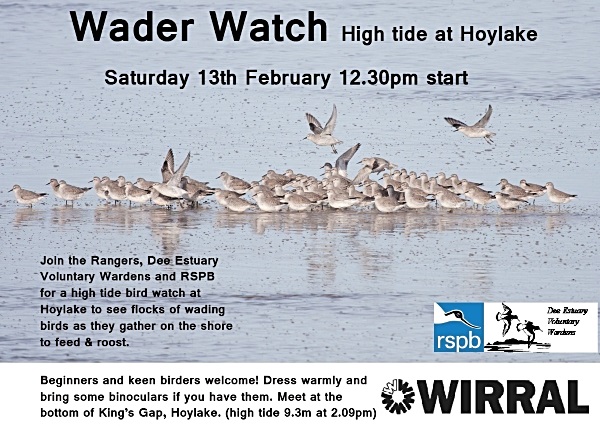
Thursday 10th March, Friday 11th March and Saturday 12th March - Parkgate RSPB High Tide Birdwatch.
Start 10.30hrs on 10th, 11.15hrs on 11th and 12 noon on 12th - It is recommended to arrive at least an hour before high tide which is: 11.54hrs on Mar 10th, 10.2m; 12.38hrs on Mar 11th, 10.2m; 13:21hrs on Mar 12th, 10.0m.
The marsh at Parkgate is one of the best wetland habitats in the northwest, and when it is flooded by an incoming Spring high tide, the wildlife which lives here is pushed closer, potentially delivering an awe-inspiring spectacle. Join us at Parkgate's Old Baths car park and the Donkey Stand near Nicholl's ice cream shop, where we'll be set up with marquees and telescopes hoping for the right weather conditions to really push the tide in.
You can expect great views of the large numbers of wintering wildfowl and wading birds shifting around to avoid the rising water, whilst the small mammals living on the marsh are flushed from cover, offering a feeding frenzy for the resident kestrels and hopefully harriers and short-eared owls returning for the winter.
Car parking is limited on Parkgate promenade, but there is free public parking at the Old Baths car park (CH64 6RN) at the north end of The Parade, and the Wirral Country Park car park on Station Road (CH64 6QJ). There are public toilets at Mostyn Square in the middle of The Parade, and a number of pubs and cafes for refreshments.
Additional parking has also kindly been offered at Marsh Nurseries, Boathouse Lane (postcode CH64 6RD).
Please note: the height of the tide can be hugely affected by the weather conditions on the day. In the event of high pressure and calm conditions, the tide will cover much less of the marsh and not reach the sea wall, whilst low pressure and strong Westerly winds will help push the tide in and offer the greatest spectacle. We recommend you check the weather forecast on the day to know exactly what to expect.
